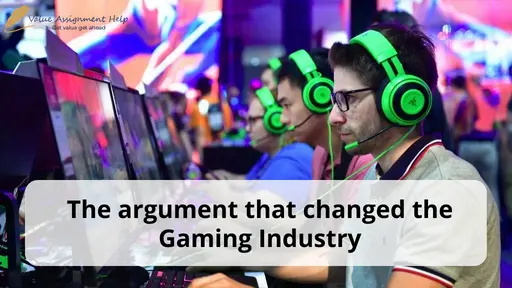
Search Assignments
Our Experts

Search Assignments

Customers Reviews
While playing games, it is very likely to get into arguments, and we all know the one who either cheats or tends to mend the rules just for the sake of winning. These arguments make or break the game and impact every individual differently. Some tend to lose their temper while others seek joy amidst the argument, but only a few sit-down and solve the problem, and we are writing this case study on one such argument that changed the narrative of board games.
“Games” are ultimate Ice-Breakers and have witnessed many strangers turn into family. Discarding the awkwardness, games have amazing social binding capabilities which encourage prosocial behaviour. Believe it or not, every individual subliminally depends upon games to Socialize with each other and why not? Games are the healthiest way to strengthen the bonds between kith and kin. Even festivities with our favourite cousins feel dull without some fun activities.

Certain games, like Football, involve physical labour while some tickle brain. But no matter the scenario, Kids and adults enjoy games alike. However, the catch is that due to vigorous physical exertion and Adrenaline rush, only a few are involved in physically challenging games. We are a team “board games” for the rest of us.
The simple and easy design of board games makes them easy to comprehend, hence explaining their popularity. There are various board games ranging from the mastermind “chess” to the apple of the eye “monopoly”, which is the most popular Board game in the world.
But our attention is pinned on a particular gaming brand originating from an argument and has now bagged 2nd rank under the gaming section of the Google Play store.
In 1970, a mighty barber named Merle Robbins lived in Ohio, US. Barber’s family, like any other household, delightedly enjoyed playing games together and one in particular- “The Crazy Eights”, a popular card-shedding game. However, the game's rules at that time varied with every new hand making it the perfect mind-bending game for strategic gameplay. Still, it also became the underlying reason for minor disagreements among the family. The game involved a combination of different cards, and the significance of each card could be changed as per convenience to make infinite gaming combinations and strategies.
The family enjoyed the game, but it soon began to nurture arguments. One fine day, the father and son disputed the game's rules. In a rage, the son went out of the house. Worrisome father on that day, sitting at the dining table of his house, manually drew the symbols on the cards with a pen. This avoided confusion during the game since every card now had an individual meaning. They called it Uno.
Robbis family was very impressed by the innovative technique and decided to share the new game with others. Leasing their own house, the Robbis family printed 5000 copies of the game at $8000 and initially sold them in their neighbourhood houses and shops; the son distributed them in the schools.
Initial 5000 copies were sold. However, the game had more potential than the family could comprehend. A businessman, Robert Tezak, then came into the picture and bought the rights for 50000 dollars at 10 percent royalty to the Robbis family. He soon began the expansion process by printing a digitally crafted card deck of 112 cards and monetizing the game as International Brand by forming International Games Inc.
In 1996, Mattel- 2nd largest toy producer and owner of Hot Wheels and Barbie- bought the game. From then onwards, “Uno” was rebranded as “UNO” and generated gradual revenue for the company. However, from that time to now, the game has been launched in many models and variants, ranging from country to country, and the popularity of the game has only grown.
UNO is a card game with 112 cards and players ranging between 2-10. The addictive game of UNO is a shedding game. UNO in Italian means one, which completely makes sense as the game's ultimate goal is to be the first to get rid of all cards. The game is a fun experience and easy to understand.
Owned by parent company Mattel, since its origin in 1971, the revenue model for the brand has changed gradually. Traditionally the game was sold in the form of a deck and, at present, has sold 151 million copies worldwide.
The brand has expanded tremendously from its early days and is now available in more than 80 countries.
UNO, however, is not an original game and was an improvement in “the crazy eights”.
In the late 1990s and early 2000s, the reason for its mass popularity was the perfect blend of simplicity and complexity. The game is simple enough to be played by children but complex enough to stir an adult's imagination, hence befitting for a wider age group. The reason for admiration in old times is understandable, simple gameplay, engaging and fun, but how has UNO still maintained its brand value in present times?
The game was initially designed to be played in groups of friends and family. But, with changing times, the number of get-togethers and social gatherings has dropped. In addition, families have become distant due to evolving job demands, and altering market structure has pushed families further. As a result, there is little to no family time.
The growing technical advancements have been a blessing to many in such dark times. To tackle the issue, online platforms have aided families by providing means of staying in touch, and UNO has been no exception. Considering the evolving market trends, Mattel expanded in the online gaming industry and launched the popular board game to a bigger and wider audience.
The brand started by devising a way to play the game on Facebook messenger. Then, later the online application provided a media for remote members of families to bond over an online game. Finally, the UNO app for electronic media turned the tables for the brand. The UNO app, along with spike in the generated revenue of the company, also bridged the gap between families, gaining mass admiration.
The move also helped the brand gain a tighter grip in Asian markets. The wildly popular game in Western countries soon became a hit in Asian markets, making it rank 2nd on Google Play Games.
However, its parent company was sinking ships. Considering the falling revenue of its parent company by 11% in 2017, UNO was Mattel’s last resort. To combat the market competition and keep business afloat, Mattel also launched the second version of UNO- “DOS”. Later, Mattel’s other gaming application, “Phase 10”, saved the boat and resulted in a spike of 600% in terms of revenue growth (500000$ to 30 Million $) with over 160 million users worldwide.
With the brand's life cycle at the maturity stage, its impacts can be visibly seen in printed media, but its digital presence is still appreciable. Originated by a common barber, the game is now wildly known to add fun to every social gathering. Millions of households worldwide now share the simple gathering solution of Robbis family, and despite many adversities along the path, UNO continues to bond people.




No Comments